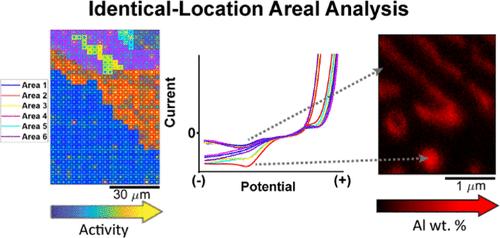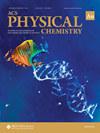Zn-Al 合金的高通量电化学-显微镜关联分析
IF 3.7
Q2 CHEMISTRY, PHYSICAL
引用次数: 0
摘要
传统电极和电催化剂具有复杂的组成和结构模式,会影响其整体电化学活性。这些图案包括电极表面的缺陷和晶体取向,以及与粘合剂等其他电极成分的层和复合材料。因此,确定这些单个结构如何改变电极的电化学活性至关重要。扫描电化学电池显微镜 (SECCM) 是一种功能强大的工具,可用于研究复杂结构的电化学特性。Zn-Al 合金就是复杂电极表面的一个例子,它被广泛应用于从钢铁阴极保护到电池电极等各个领域。本文利用伏安法 SECCM 和相关微观结构分析来探究一系列微观结构特征的电化学活性,在锌铝合金表面的六个不同区域进行了 651 次独立伏安法测量。能量色散 X 射线光谱(EDS)图显示,合金结构的特定相,特别是 Zn-Al 的 α 相,有利于金属溶解(即氧化)和电化学还原过程的早期阶段,如氧还原反应(ORR)和溶解金属离子的再沉积。通过比较高分辨率定量元素组成(即 EDS)和相应的空间分辨循环伏安图(即 SECCM)进行的相关分析表明,锌-铝合金的纳米点 α 相含有较高的铝含量(30-50%),这可能会在无缓冲水介质中发生 ORR 时,随着局部 pH 值的增加而促进局部铝的溶解。总之,基于 SECCM 的高通量电化学筛选与微观结构分析相结合,最终证明了结构-组成异质性会显著影响复杂电极表面的局部电化学活性。这些见解对于合理设计先进的电材料非常宝贵。本文章由计算机程序翻译,如有差异,请以英文原文为准。

High Throughput Correlative Electrochemistry-Microscopy Analysis on a Zn–Al Alloy
Conventional electrodes and electrocatalysts possess complex compositional and structural motifs that impact their overall electrochemical activity. These motifs range from defects and crystal orientation on the electrode surface to layers and composites with other electrode components, such as binders. Therefore, it is vital to identify how these individual motifs alter the electrochemical activity of the electrode. Scanning electrochemical cell microscopy (SECCM) is a powerful tool that has been developed for investigating the electrochemical properties of complex structures. An example of a complex electrode surface is Zn–Al alloys, which are utilized in various sectors ranging from cathodic protection of steel to battery electrodes. Herein, voltammetric SECCM and correlative microstructure analysis are deployed to probe the electrochemical activities of a range of microstructural features, with 651 independent voltammetric measurements made in six distinctive areas on the surface of a Zn–Al alloy. Energy-dispersive X-ray spectroscopy (EDS) mapping reveals that specific phases of the alloy structure, particularly the α-phase Zn–Al, favor the early stages of metal dissolution (i.e., oxidation) and electrochemical reduction processes such as the oxygen reduction reaction (ORR) and redeposition of dissolved metal ions. A correlative analysis performed by comparing high-resolution quantitative elemental composition (i.e., EDS) with the corresponding spatially resolved cyclic voltammograms (i.e., SECCM) shows that the nanospot α-phase of the Zn–Al alloy contains high Al content (30–50%), which may facilitate local Al dissolution as the local pH increases during the ORR in unbuffered aqueous media. Overall, SECCM-based high-throughput electrochemical screening, combined with microstructure analysis, conclusively demonstrates that structure-composition heterogeneity significantly influences the local electrochemical activity on complex electrode surfaces. These insights are invaluable for the rational design of advanced electromaterials.
求助全文
通过发布文献求助,成功后即可免费获取论文全文。
去求助
来源期刊
CiteScore
3.70
自引率
0.00%
发文量
0
期刊介绍:
ACS Physical Chemistry Au is an open access journal which publishes original fundamental and applied research on all aspects of physical chemistry. The journal publishes new and original experimental computational and theoretical research of interest to physical chemists biophysical chemists chemical physicists physicists material scientists and engineers. An essential criterion for acceptance is that the manuscript provides new physical insight or develops new tools and methods of general interest. Some major topical areas include:Molecules Clusters and Aerosols; Biophysics Biomaterials Liquids and Soft Matter; Energy Materials and Catalysis

 求助内容:
求助内容: 应助结果提醒方式:
应助结果提醒方式:


